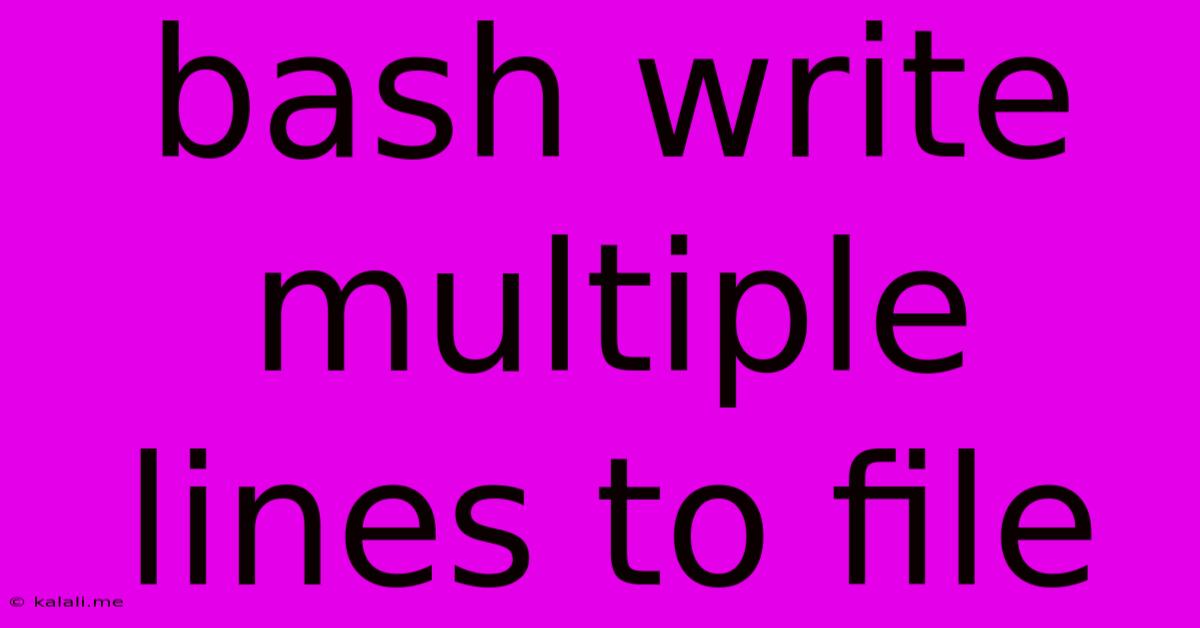Bash Write Multiple Lines To File
Kalali
May 31, 2025 · 3 min read

Table of Contents
Bash: Writing Multiple Lines to a File – Efficient Methods and Best Practices
Writing multiple lines to a file in bash scripting is a fundamental task with several approaches, each offering varying degrees of efficiency and readability. This guide explores effective methods, best practices, and considerations for optimizing your bash scripts. This article covers techniques for appending and overwriting files, handling potential errors, and improving script performance.
Understanding the Core Methods
The most common ways to write multiple lines to a file involve using redirection, echo, and printf. Let's break down each method and its advantages:
1. Using Here Strings and Redirection (<<< and >):
This approach is concise and suitable for writing small, fixed sets of lines. The <<< operator creates a "here string," providing input directly to a command. The > operator redirects the output to a file, overwriting any existing content.
#!/bin/bash
> myfile.txt <<< "This is the first line.\nThis is the second line.\nThis is the third line."
cat myfile.txt
This method is efficient for smaller outputs but becomes less manageable for larger, dynamically generated content. The \n character is crucial for creating new lines.
2. Using echo with Redirection:
echo is a versatile command that prints text to the standard output. Combining it with redirection (>) allows you to write multiple lines to a file, one echo command per line.
#!/bin/bash
> myfile.txt
echo "Line 1" >> myfile.txt
echo "Line 2" >> myfile.txt
echo "Line 3" >> myfile.txt
cat myfile.txt
Note the use of >> for appending to the file. Using > would overwrite the file each time. This approach is clear and easy to understand, particularly for scripts with a relatively small number of lines.
3. Using printf with Redirection:
printf offers more control over formatting than echo. It's particularly useful when you need precise formatting, especially with variables.
#!/bin/bash
> myfile.txt
printf "Line 1: %s\n" "Value 1" >> myfile.txt
printf "Line 2: %d\n" 123 >> myfile.txt
printf "Line 3: %f\n" 3.14 >> myfile.txt
cat myfile.txt
printf provides better control over line breaks and variable insertion, making it suitable for complex scenarios.
4. Using Loops and Arrays for Dynamic Content:
For generating multiple lines dynamically, using loops and arrays offers the best flexibility. This is especially important when dealing with large datasets or varying line counts.
#!/bin/bash
myarray=("Line 1" "Line 2" "Line 3" "Line 4" "Line 5")
> myfile.txt
for i in "${myarray[@]}"; do
echo "$i" >> myfile.txt
done
cat myfile.txt
This approach allows you to efficiently handle dynamic data and easily scale the number of lines written to the file.
Best Practices and Error Handling
- Always use double quotes around variables: This prevents word splitting and globbing issues.
- Append (
>>) instead of overwriting (>) unless you explicitly want to clear the file: This prevents accidental data loss. - Check for errors: Use
$?to check the exit status of commands. A non-zero exit status indicates an error. - Use appropriate permissions: Ensure the script has write access to the target directory and file.
- Consider using a temporary file: Write to a temporary file and then rename it to the final filename to avoid partial writes in case of interruptions.
Optimizing for Performance
For extremely large numbers of lines, consider using tools like awk or specialized utilities designed for efficient file manipulation. These tools are often optimized for speed and memory management, resulting in better performance compared to repeated echo or printf calls within a loop.
By understanding these methods and applying best practices, you can write robust and efficient bash scripts for managing files and their contents. Remember to choose the method best suited to your specific needs and always prioritize error handling and clear, readable code.
Latest Posts
Latest Posts
-
Te Echo De Menos In English
Jun 01, 2025
-
Request The Pleasure Of Your Company
Jun 01, 2025
-
Why Is Power Conserved In Transformers
Jun 01, 2025
-
How To Wire Up A Light To A Switch
Jun 01, 2025
-
Where Will Satan Be After The Millennium
Jun 01, 2025
Related Post
Thank you for visiting our website which covers about Bash Write Multiple Lines To File . We hope the information provided has been useful to you. Feel free to contact us if you have any questions or need further assistance. See you next time and don't miss to bookmark.